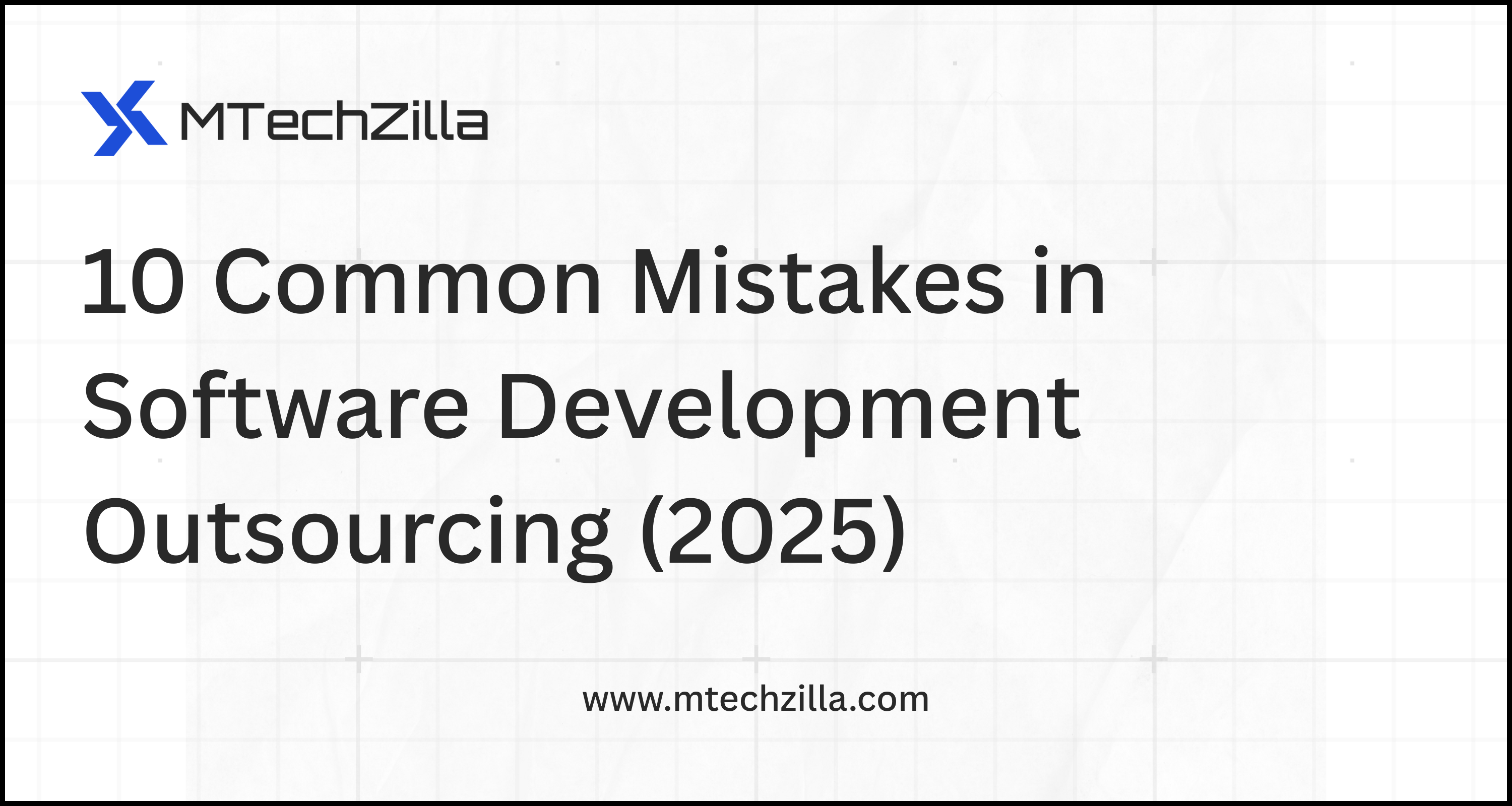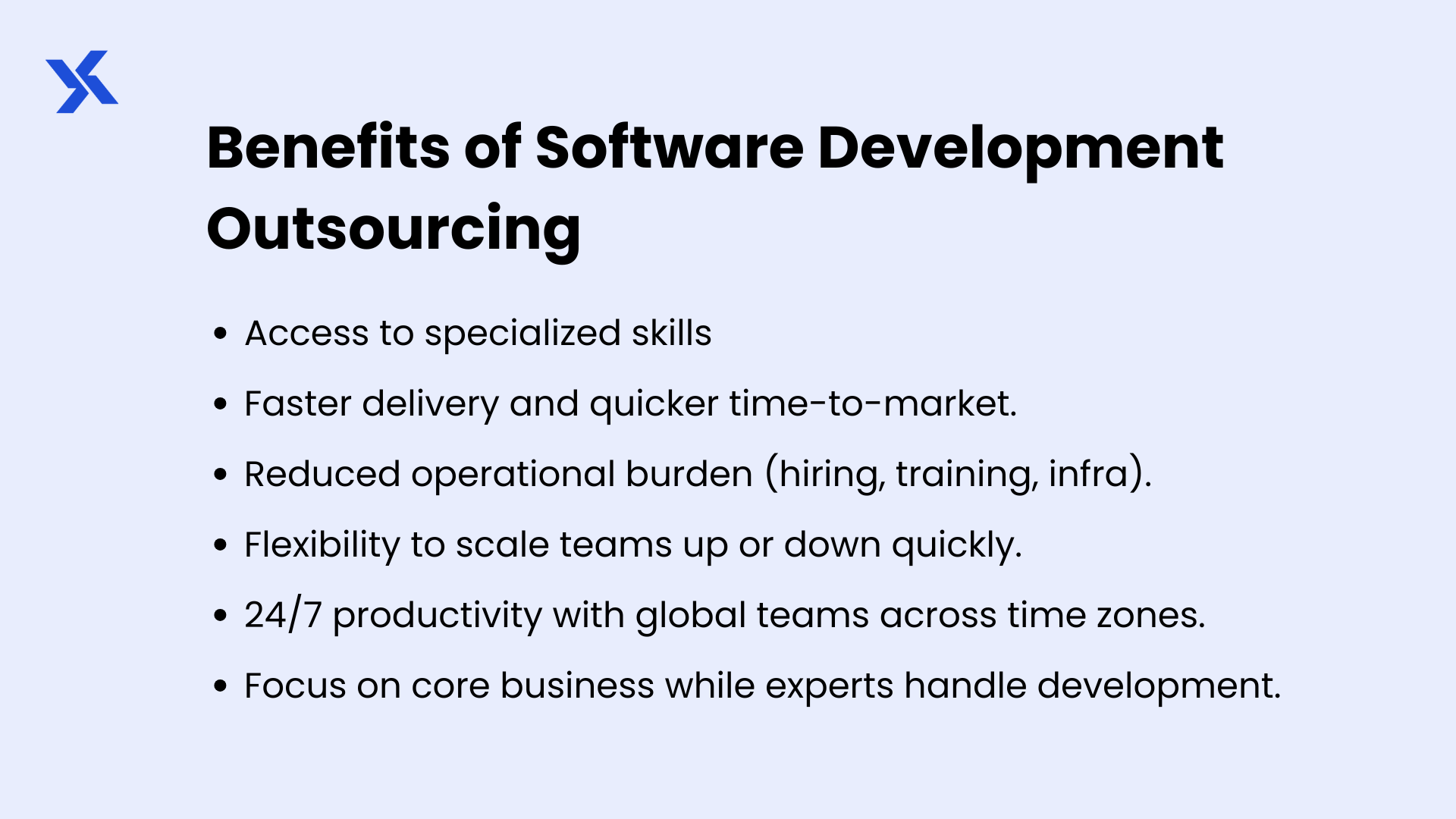August 26, 2025
12 min read

The year 2025 is shaping up to be a turning point for businesses everywhere. More and more companies are outsourcing their software development. But why is this happening now?
The demand for AI-driven products, automation, and digital-first customer experiences is exploding. At the same time, costs for engineers, especially in the United States and Europe, continue to skyrocket. In today’s competitive landscape, speed has become everything. Falling behind on a product launch can mean losing your edge entirely.
According to Grand View Research, the global IT services outsourcing market was valued at USD 744.6 billion in 2024 and is projected to reach USD 1,219.3 billion by 2030, growing at a CAGR of 8.6 percent from 2025 onwards.
For smaller companies that often run on tighter budgets and leaner teams, outsourcing has become the most practical way to scale without overstretching resources.
This is exactly why outsourcing is no longer just a backup plan. It has become a critical growth strategy. And as you read this blog, we want you to look at every mistake and ask yourself: “Could this be happening in my own company?” It’s important to understand these 10 Common Mistakes in Software Development Outsourcing before they slow down your business too.
Introduction
What is Software Development Outsourcing?
Why Businesses are Turning to Software Development Outsourcing
10 Most Common Mistakes in Software Development Outsourcing
How to Select a Software Development Outsourcing Partner
What Software Development Outsourcing Looks Like at MTechZilla
FAQs
At its core, software development outsourcing is when a company hires an external partner or team to handle part or all of its software projects instead of doing everything in-house. But in practice, it is much more than just “sending work outside.” It is about bringing in external expertise, processes, and resources to fill gaps that your internal team cannot cover.
Here is what typically happens inside an outsourcing arrangement:
Defining the need: A company realizes it cannot build or maintain software alone, often due to skill gaps, limited developers, or the need for speed.
Choosing a partner: The business evaluates outsourcing firms based on expertise, pricing, track record, and communication style.
Setting the scope: Both sides agree on what will be done, whether it is full product development, app maintenance, QA, or building a remote team.
Execution and collaboration: The outsourced team develops the project while staying in sync through tools like Jira, Trello, Slack, or Zoom.
Delivery and scaling: Once delivered and tested, the partnership often continues with updates, support, or even scaling into a long-term collaboration.
The real reason companies outsource in 2025 is not just cost savings anymore. Yes, outsourcing is often cheaper than hiring full-time developers in expensive markets like the U.S. or Europe. But more importantly:
It gives access to specialized skills like AI, blockchain, or cybersecurity that are hard to find locally.
It speeds up delivery, allowing companies to launch products faster and stay ahead of competitors.
It reduces operational burden since the outsourcing partner handles recruitment, training, and sometimes even infrastructure.
It allows focus on core business, while technical experts handle the development heavy lifting.

Now let’s jump into the 10 common mistakes businesses make when hiring a software development outsourcing company for their project.
When businesses outsource software development, they often repeat the same mistakes that can cost them time, money, and growth. The three most common ones are not defining the project clearly, choosing the wrong outsourcing partner, and skipping strong contracts.
Below, we break down each mistake, why it matters, and how you can avoid it. For every mistake, we’ve also included the best practice to follow.
Many businesses jump into outsourcing because they want to save time. Startups in particular often think, “We’ll figure things out along the way.” They hand over only a rough idea of the product without clear documentation.
Impact
This lack of clarity almost always leads to endless revisions. Developers build something, the client says “this is not what we wanted,” and both sides lose time and money. Deadlines stretch, frustration grows, and budgets spiral out of control. For a startup, it could even mean missing a funding milestone because the MVP wasn’t ready on time.
How to avoid
Treat documentation as your blueprint. Create user stories, wireframes, and clear success criteria before development starts. If you don’t have time to do it alone, ask the software development service provider for a discovery workshop. Spending one or two weeks here can save months of chaos later.
For small businesses or solopreneurs, budgets are tight. The cheapest quote looks like the smartest decision. The thought process is usually, “Why pay $50 an hour when someone is offering $15?”
Impact
Low-cost often means low-quality. Corners are cut, senior developers are swapped for juniors, and code quality suffers. The immediate project may seem “done,” but hidden issues pile up. Eventually, you end up paying double to fix problems or rebuild from scratch.
How to avoid
Instead of asking, “How cheap can I get this done?” ask, “What is the long-term value this partner brings?” Evaluate software development companies on expertise, communication, reliability, and track record. A slightly higher upfront cost often prevents massive losses later.
Under pressure to launch quickly, businesses skip due diligence. They may pick the first vendor they find on Google or a referral without doing deeper checks.
Impact
The wrong partner can derail your entire project. Deadlines slip, promises are broken, and cultural mismatches lead to poor collaboration. In worst cases, companies disappear mid-project, leaving you stranded.
How to avoid
Always vet your outsourcing partner. Look at case studies, speak to past clients, and even do a small pilot project before committing to a long-term contract. Assess technical skills and, just as importantly, communication habits.
Businesses often assume the outsourcing partner will “handle everything” without defining boundaries. The partner expects the client to guide decisions, while the client expects full ownership from the partner.
Impact
This leads to duplication, confusion, and major delays. Teams argue over ownership, and decisions are made late. Business owners waste time micromanaging instead of focusing on strategy.
How to avoid
From day one, set clear roles. Decide who owns requirements, who approves deliverables, and who manages communication. Appoint a project manager or product owner on your side to keep alignment smooth.

Some businesses approach outsourcing as a quick “buy-and-deliver” service. They see it like ordering a product, not building a relationship.
Impact
This mindset creates an “us vs them” dynamic. Outsourced developers feel disconnected from the company’s vision, leading to lower motivation and poorer quality work. Innovation is lost because the partner never feels like part of the bigger picture.
How to avoid
Build a partnership, not just a contract. Share your vision, involve the team in brainstorming, and celebrate milestones together. When your software development service partner feels invested, the results are far better.”
Companies underestimate the importance of communication rhythms. They assume a weekly update is enough, or they ignore cultural differences in how people work.
Impact
Misunderstandings pile up. A simple delay in clarifying requirements can add weeks of wasted effort. Time-zone mismatches make it harder to collaborate in real-time. Cultural disconnects sometimes lead to developers being hesitant to ask questions or raise concerns.
How to avoid
Establish overlapping work hours. Use project management tools like Jira, and agree on communication channels (Slack, Zoom, email). More importantly, foster openness - make it clear the partner can ask questions without hesitation.
Businesses in a rush often sign generic contracts or handshake deals without considering intellectual property, security, or support obligations.
Impact
This can lead to devastating outcomes. You may lose ownership of your code, face unexpected fees, or struggle with poor support once the project ends. Worse, sensitive data may not be legally protected.
How to avoid
Always draft detailed contracts. Include IP ownership clauses, data security commitments, support agreements, and clear SLAs (Service Level Agreements). If needed, get a legal expert to review before signing.
Founders, especially in early-stage startups, focus entirely on speed and functionality. Security gets pushed aside with the mindset, “We’ll handle that later.”
Impact
Later usually never comes. Security flaws lead to breaches, regulatory fines, and loss of customer trust. One data leak can destroy years of hard work and credibility.
How to avoid
Prioritize security from the start. Ask vendors about their compliance with GDPR, HIPAA, or relevant industry standards. Build in authentication, encryption, and secure coding practices as part of the scope, not an afterthought.
Businesses often assume the outsourcing partner will “naturally” include QA or think testing can wait until the end.
Impact
Bugs slip into production, causing angry users, bad reviews, and rework costs. On top of that, poorly documented or sloppy code makes future changes slow and expensive.
How to avoid
Make QA and maintainability non-negotiable. Define testing standards in the contract, request automated test coverage, and insist on clean, well-documented code. This ensures your product can scale smoothly later.
Many companies treat outsourcing as a one-off task. They think, “We just need this app built,” without considering future updates or scaling.
Impact
When the app needs new features, they start from scratch with new vendors, wasting time and repeating onboarding. They lose continuity, trust, and institutional knowledge that could have helped the product evolve faster.
How to avoid
Think long-term. Even if you start small, build relationships with partners who can grow with you. Include plans for ongoing maintenance, updates, and scaling. Strong outsourcing partnerships often become strategic assets, not just service providers.
Software development outsourcing in 2025 is full of opportunities, but only if you avoid these common mistakes. Before ending this discussion, let’s take a quick look at the factors that matter most when selecting a software development outsourcing agency.
Choosing the right software development outsourcing partner can make or break your project. To help you make an informed decision, here’s a step-by-step checklist you can follow:
Outline your project scope, business objectives, and success criteria.
Write down must-have features vs. nice-to-have features.
Explore verified platforms like Clutch, GoodFirms, and industry reports.
Shortlist at least three vendors for proposals and interviews.
Look for recent and relevant case studies and always ask for client references.
Your RFP should cover:
Functional requirements
Expected deliverables
Timelines and milestones
Budget constraints
Security and compliance expectations
Run short workshops with each shortlisted vendor.
This helps you assess their understanding of your project and problem-solving approach.
Look for clarity, realistic promises, and cultural fit.
Avoid vendors who overpromise or are vague about their processes.
Some essential questions include:
How do you handle communication and reporting?
What is your escalation process for major issues?
Can you show recent examples of similar projects?
What security and data protection measures do you follow?
Insist on clear contracts, well-defined SLAs, and IP ownership clauses.
Always sign non-disclosure agreements (NDAs) to protect sensitive information.
Begin with a pilot project or milestone-based delivery.
Scale up once the vendor has proven reliability, quality, and communication strength.

Our team at MTechZilla has a proven record of helping fast-growing startups avoid these mistakes and launch successful software projects.
We make sure code quality and documentation are never compromised, because we know that maintainability matters as much as delivery. We use agile methodology, dividing tasks into weekly sprints to give clients full visibility.
Most importantly, we believe in transparency and clarity — every client has complete ownership of their code and intellectual property, along with proper handovers and knowledge transfer. These are not just processes, but actionable steps we consistently follow. And this is the reason why many of our clients choose to work with us long term.
If you’re in the process of looking for a software development outsourcing partner, book a free consultation call to discuss how we can support your project within your budget.
The biggest mistake in software development outsourcing is starting without clear requirements. Vague goals and missing details often lead to misaligned expectations, costly rework, and project delays. This happens when businesses rush into coding without proper planning. The solution is to invest time in discovery and documentation before development begins.
A trustworthy software outsourcing company is one that has a proven track record and transparency in how it works. Start by checking verified platforms like Clutch and GoodFirms for client reviews, case studies, and ratings. Always request references and speak directly with past clients if possible. Most importantly, meet the actual delivery team, not just the salespeople, to assess their expertise, communication style, and cultural fit before signing any agreement.
In 2025, outsourcing software development typically costs $20–$150 per hour, depending on region and expertise. Small MVPs or basic apps can range from $20,000–$60,000, while mid-size projects often cost $150,000–$500,000. Large enterprise platforms may exceed $1M–$2M when factoring in integrations and long-term support. Final costs depend heavily on project scope, tech stack, and location of your outsourcing partner.
How do I manage an outsourced software team effectively?
Assign a dedicated in-house project manager, communicate via agreed channels, set clear KPIs, use collaborative tools, and schedule regular check-ins for alignment and feedback.


Share your product idea and challenges

Discuss possible approaches and solutions

Define a roadmap for your project